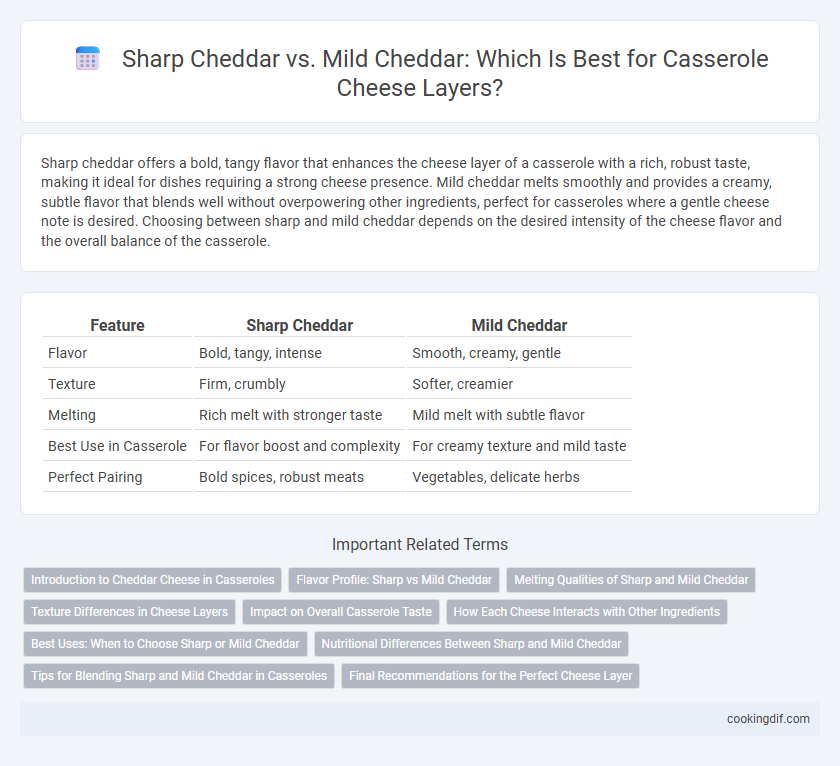Sharp cheddar offers a bold, tangy flavor that enhances the cheese layer of a casserole with a rich, robust taste, making it ideal for dishes requiring a strong cheese presence. Mild cheddar melts smoothly and provides a creamy, subtle flavor that blends well without overpowering other ingredients, perfect for casseroles where a gentle cheese note is desired. Choosing between sharp and mild cheddar depends on the desired intensity of the cheese flavor and the overall balance of the casserole.
Table of Comparison
| Feature | Sharp Cheddar | Mild Cheddar |
|---|---|---|
| Flavor | Bold, tangy, intense | Smooth, creamy, gentle |
| Texture | Firm, crumbly | Softer, creamier |
| Melting | Rich melt with stronger taste | Mild melt with subtle flavor |
| Best Use in Casserole | For flavor boost and complexity | For creamy texture and mild taste |
| Perfect Pairing | Bold spices, robust meats | Vegetables, delicate herbs |
Introduction to Cheddar Cheese in Casseroles
Cheddar cheese, a staple in many casserole recipes, varies in flavor intensity with sharp and mild options offering distinct taste profiles. Sharp cheddar, aged longer, provides a tangier, more robust flavor that enhances the depth of savory casseroles, while mild cheddar delivers a creamier, subtler taste ideal for lighter, smoother dishes. Choosing between sharp and mild cheddar depends on the desired flavor impact and overall balance within the casserole's cheese layer.
Flavor Profile: Sharp vs Mild Cheddar
Sharp cheddar delivers a bold, tangy flavor with a pronounced sharpness that enhances the casserole's richness, creating a more intense taste experience. Mild cheddar offers a smoother, creamier texture and a subtle, buttery flavor that blends seamlessly without overpowering other ingredients. Choosing sharp cheddar adds depth and complexity, while mild cheddar provides a milder, more balanced cheese layer in casseroles.
Melting Qualities of Sharp and Mild Cheddar
Sharp cheddar cheese melts with a rich, creamy texture that enhances the casserole's flavor complexity, while mild cheddar provides a smoother, more uniform melt ideal for a subtle cheese layer. The higher acidity and aged nature of sharp cheddar contribute to a slightly firmer melt, creating a distinct cheesy crust. In contrast, mild cheddar's younger, less acidic composition results in a softer, more consistent melt that blends seamlessly with other casserole ingredients.
Texture Differences in Cheese Layers
Sharp cheddar offers a crumbly, firm texture that creates a distinct, robust cheese layer in casseroles, enhancing structural integrity during baking. Mild cheddar melts smoothly, producing a creamy, softer cheese layer that blends seamlessly with other ingredients for a velvety consistency. The choice between sharp and mild cheddar affects the casserole's mouthfeel, with sharp cheddar adding bite and mild cheddar providing a mellow, cohesive texture.
Impact on Overall Casserole Taste
Sharp cheddar offers a bold, tangy flavor that intensifies the overall taste profile of a casserole, creating a richer and more pronounced cheese layer. Mild cheddar provides a creamy, subtle taste that blends seamlessly with other ingredients, enhancing the casserole's texture without overpowering flavors. Choosing sharp cheddar elevates complexity and depth, while mild cheddar maintains balance and smoothness in the dish.
How Each Cheese Interacts with Other Ingredients
Sharp cheddar contributes a bold, tangy flavor that intensifies the overall taste of a casserole, enhancing spices and balancing richness from creamy or starchy ingredients. Mild cheddar offers a subtle, creamy texture that melts smoothly, allowing other flavors like vegetables or proteins to stand out without overpowering the dish. The melting properties of sharp cheddar create a slightly firmer cheese layer, while mild cheddar produces a softer, more cohesive texture that integrates seamlessly with mixed ingredients.
Best Uses: When to Choose Sharp or Mild Cheddar
Sharp cheddar works best in casseroles needing a bold, tangy flavor that stands out, pairing well with robust ingredients like caramelized onions or spicy sausage. Mild cheddar suits casseroles where a creamy, subtle cheese taste is preferred, such as chicken or vegetable bakes, enhancing texture without overpowering other flavors. Choosing sharp or mild cheddar depends on whether the dish calls for a dominant cheese presence or a gentle, mellow complement.
Nutritional Differences Between Sharp and Mild Cheddar
Sharp cheddar cheese contains slightly higher protein levels and calcium than mild cheddar due to its longer aging process, which also intensifies flavor without significantly increasing fat content. Mild cheddar offers a smoother texture and lower sodium content, making it a gentler option for heart health while still providing essential nutrients like vitamin A and phosphorus. Both varieties deliver comparable calories and saturated fat, but sharp cheddar's richer nutrient density supports stronger bone health and muscle maintenance.
Tips for Blending Sharp and Mild Cheddar in Casseroles
Blending sharp and mild cheddar in casseroles balances bold flavor with creamy texture, enhancing overall taste without overpowering other ingredients. Use a ratio of two parts mild cheddar to one part sharp cheddar for optimal meltability and flavor depth. Grate cheeses evenly and mix thoroughly to ensure a consistent cheese layer that melts smoothly and complements the casserole's richness.
Final Recommendations for the Perfect Cheese Layer
Sharp cheddar enhances casseroles with a robust, tangy flavor that intensifies during baking, creating a bold, savory cheese layer. Mild cheddar offers a creamy, subtle taste and smooth texture, ideal for those preferring a less intense cheese presence. For a perfect cheese layer, blend sharp and mild cheddar to balance strong flavor with melt-in-your-mouth creaminess.
Sharp cheddar vs Mild cheddar for cheese layer Infographic

 cookingdif.com
cookingdif.com